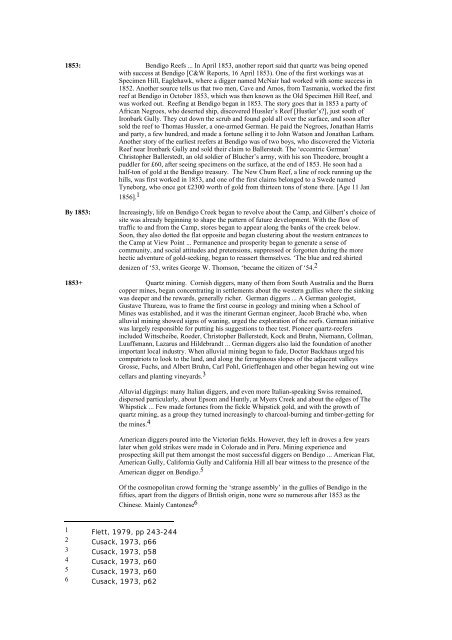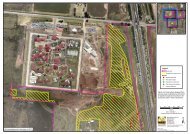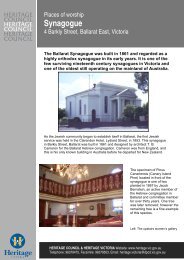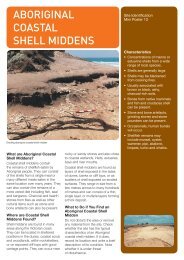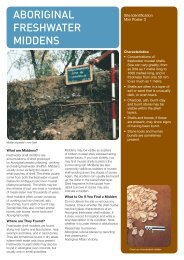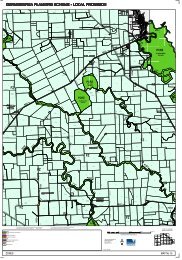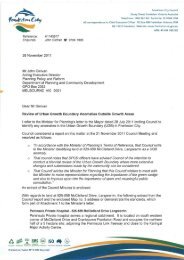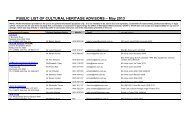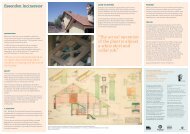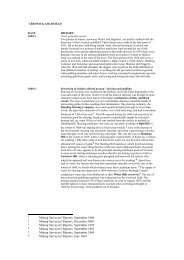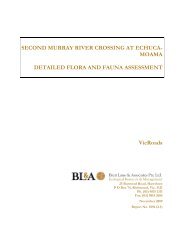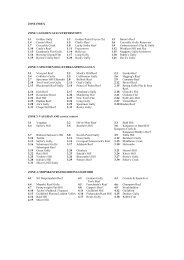Bendigo General History - Department of Planning and Community ...
Bendigo General History - Department of Planning and Community ...
Bendigo General History - Department of Planning and Community ...
Create successful ePaper yourself
Turn your PDF publications into a flip-book with our unique Google optimized e-Paper software.
1853: <strong>Bendigo</strong> Reefs ... In April 1853, another report said that quartz was being opened<br />
with success at <strong>Bendigo</strong> [C&W Reports, 16 April 1853). One <strong>of</strong> the first workings was at<br />
Specimen Hill, Eaglehawk, where a digger named McNair had worked with some success in<br />
1852. Another source tells us that two men, Cave <strong>and</strong> Amos, from Tasmania, worked the first<br />
reef at <strong>Bendigo</strong> in October 1853, which was then known as the Old Specimen Hill Reef, <strong>and</strong><br />
was worked out. Reefing at <strong>Bendigo</strong> began in 1853. The story goes that in 1853 a party <strong>of</strong><br />
African Negroes, who deserted ship, discovered Hussler’s Reef [Hustler’s?], just south <strong>of</strong><br />
Ironbark Gully. They cut down the scrub <strong>and</strong> found gold all over the surface, <strong>and</strong> soon after<br />
sold the reef to Thomas Hussler, a one-armed German. He paid the Negroes, Jonathan Harris<br />
<strong>and</strong> party, a few hundred, <strong>and</strong> made a fortune selling it to John Watson <strong>and</strong> Jonathan Latham.<br />
Another story <strong>of</strong> the earliest reefers at <strong>Bendigo</strong> was <strong>of</strong> two boys, who discovered the Victoria<br />
Reef near Ironbark Gully <strong>and</strong> sold their claim to Ballerstedt. The ‘eccentric German’<br />
Christopher Ballerstedt, an old soldier <strong>of</strong> Blucher’s army, with his son Theodore, brought a<br />
puddler for £60, after seeing specimens on the surface, at the end <strong>of</strong> 1853. He soon had a<br />
half-ton <strong>of</strong> gold at the <strong>Bendigo</strong> treasury. The New Chum Reef, a line <strong>of</strong> rock running up the<br />
hills, was first worked in 1853, <strong>and</strong> one <strong>of</strong> the first claims belonged to a Swede named<br />
Tyneborg, who once got £2300 worth <strong>of</strong> gold from thirteen tons <strong>of</strong> stone there. [Age 11 Jan<br />
1856]. 1<br />
By 1853: Increasingly, life on <strong>Bendigo</strong> Creek began to revolve about the Camp, <strong>and</strong> Gilbert’s choice <strong>of</strong><br />
site was already beginning to shape the pattern <strong>of</strong> future development. With the flow <strong>of</strong><br />
traffic to <strong>and</strong> from the Camp, stores began to appear along the banks <strong>of</strong> the creek below.<br />
Soon, they also dotted the flat opposite <strong>and</strong> began clustering about the western entrances to<br />
the Camp at View Point ... Permanence <strong>and</strong> prosperity began to generate a sense <strong>of</strong><br />
community, <strong>and</strong> social attitudes <strong>and</strong> pretensions, suppressed or forgotten during the more<br />
hectic adventure <strong>of</strong> gold-seeking, began to reassert themselves. ‘The blue <strong>and</strong> red shirted<br />
denizen <strong>of</strong> ‘53, writes George W. Thomson, ‘became the citizen <strong>of</strong> ‘54. 2<br />
1853+ Quartz mining. Cornish diggers, many <strong>of</strong> them from South Australia <strong>and</strong> the Burra<br />
copper mines, began concentrating in settlements about the western gullies where the sinking<br />
was deeper <strong>and</strong> the rewards, generally richer. German diggers ... A German geologist,<br />
Gustave Thureau, was to frame the first course in geology <strong>and</strong> mining when a School <strong>of</strong><br />
Mines was established, <strong>and</strong> it was the itinerant German engineer, Jacob Braché who, when<br />
alluvial mining showed signs <strong>of</strong> waning, urged the exploration <strong>of</strong> the reefs. German initiative<br />
was largely responsible for putting his suggestions to thee test. Pioneer quartz-reefers<br />
included Wittscheibe, Roeder, Christopher Ballerstedt, Kock <strong>and</strong> Bruhn, Niemann, Collman,<br />
Luuffsmann, Lazarus <strong>and</strong> Hildebr<strong>and</strong>t ... German diggers also laid the foundation <strong>of</strong> another<br />
important local industry. When alluvial mining began to fade, Doctor Backhaus urged his<br />
compatriots to look to the l<strong>and</strong>, <strong>and</strong> along the ferruginous slopes <strong>of</strong> the adjacent valleys<br />
Grosse, Fuchs, <strong>and</strong> Albert Bruhn, Carl Pohl, Grieffenhagen <strong>and</strong> other began hewing out wine<br />
cellars <strong>and</strong> planting vineyards. 3<br />
Alluvial diggings: many Italian diggers, <strong>and</strong> even more Italian-speaking Swiss remained,<br />
dispersed particularly, about Epsom <strong>and</strong> Huntly, at Myers Creek <strong>and</strong> about the edges <strong>of</strong> The<br />
Whipstick ... Few made fortunes from the fickle Whipstick gold, <strong>and</strong> with the growth <strong>of</strong><br />
quartz mining, as a group they turned increasingly to charcoal-burning <strong>and</strong> timber-getting for<br />
the mines. 4<br />
American diggers poured into the Victorian fields. However, they left in droves a few years<br />
later when gold strikes were made in Colorado <strong>and</strong> in Peru. Mining experience <strong>and</strong><br />
prospecting skill put them amongst the most successful diggers on <strong>Bendigo</strong> ... American Flat,<br />
American Gully, California Gully <strong>and</strong> California Hill all bear witness to the presence <strong>of</strong> the<br />
American digger on <strong>Bendigo</strong>. 5<br />
Of the cosmopolitan crowd forming the ‘strange assembly’ in the gullies <strong>of</strong> <strong>Bendigo</strong> in the<br />
fifties, apart from the diggers <strong>of</strong> British origin, none were so numerous after 1853 as the<br />
Chinese. Mainly Cantonese 6<br />
1 Flett, 1979, pp 243-244<br />
2 Cusack, 1973, p66<br />
3 Cusack, 1973, p58<br />
4 Cusack, 1973, p60<br />
5 Cusack, 1973, p60<br />
6 Cusack, 1973, p62


